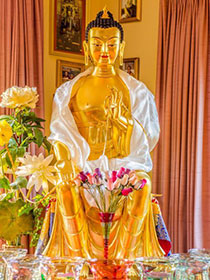- Home
- FPMT Homepage
Foundation for the Preservation of the Mahayana Tradition
The FPMT is an organization devoted to preserving and spreading Mahayana Buddhism worldwide by creating opportunities to listen, reflect, meditate, practice and actualize the unmistaken teachings of the Buddha and based on that experience spreading the Dharma to sentient beings. We provide integrated education through which people’s minds and hearts can be transformed into their highest potential for the benefit of others, inspired by an attitude of universal responsibility and service. We are committed to creating harmonious environments and helping all beings develop their full potential of infinite wisdom and compassion. Our organization is based on the Buddhist tradition of Lama Tsongkhapa of Tibet as taught to us by our founders Lama Thubten Yeshe and Lama Thubten Zopa Rinpoche.
- Willkommen
Die Stiftung zur Erhaltung der Mahayana Tradition (FPMT) ist eine Organisation, die sich weltweit für die Erhaltung und Verbreitung des Mahayana-Buddhismus einsetzt, indem sie Möglichkeiten schafft, den makellosen Lehren des Buddha zuzuhören, über sie zur reflektieren und zu meditieren und auf der Grundlage dieser Erfahrung das Dharma unter den Lebewesen zu verbreiten.
Wir bieten integrierte Schulungswege an, durch denen der Geist und das Herz der Menschen in ihr höchstes Potential verwandelt werden zum Wohl der anderen – inspiriert durch eine Haltung der universellen Verantwortung und dem Wunsch zu dienen. Wir haben uns verpflichtet, harmonische Umgebungen zu schaffen und allen Wesen zu helfen, ihr volles Potenzial unendlicher Weisheit und grenzenlosen Mitgefühls zu verwirklichen.
Unsere Organisation basiert auf der buddhistischen Tradition von Lama Tsongkhapa von Tibet, so wie sie uns von unseren Gründern Lama Thubten Yeshe und Lama Thubten Zopa Rinpoche gelehrt wird.
- Bienvenidos
La Fundación para la preservación de la tradición Mahayana (FPMT) es una organización que se dedica a preservar y difundir el budismo Mahayana en todo el mundo, creando oportunidades para escuchar, reflexionar, meditar, practicar y actualizar las enseñanzas inconfundibles de Buda y en base a esa experiencia difundir el Dharma a los seres.
Proporcionamos una educación integrada a través de la cual las mentes y los corazones de las personas se pueden transformar en su mayor potencial para el beneficio de los demás, inspirados por una actitud de responsabilidad y servicio universales. Estamos comprometidos a crear ambientes armoniosos y ayudar a todos los seres a desarrollar todo su potencial de infinita sabiduría y compasión.
Nuestra organización se basa en la tradición budista de Lama Tsongkhapa del Tíbet como nos lo enseñaron nuestros fundadores Lama Thubten Yeshe y Lama Zopa Rinpoche.
A continuación puede ver una lista de los centros y sus páginas web en su lengua preferida.
- Bienvenue
L’organisation de la FPMT a pour vocation la préservation et la diffusion du bouddhisme du mahayana dans le monde entier. Elle offre l’opportunité d’écouter, de réfléchir, de méditer, de pratiquer et de réaliser les enseignements excellents du Bouddha, pour ensuite transmettre le Dharma à tous les êtres. Nous proposons une formation intégrée grâce à laquelle le cœur et l’esprit de chacun peuvent accomplir leur potentiel le plus élevé pour le bien d’autrui, inspirés par le sens du service et une responsabilité universelle. Nous nous engageons à créer un environnement harmonieux et à aider tous les êtres à épanouir leur potentiel illimité de compassion et de sagesse. Notre organisation s’appuie sur la tradition guéloukpa de Lama Tsongkhapa du Tibet, telle qu’elle a été enseignée par nos fondateurs Lama Thoubtèn Yéshé et Lama Zopa Rinpoché.
Visitez le site de notre Editions Mahayana pour les traductions, conseils et nouvelles du Bureau international en français.
Voici une liste de centres et de leurs sites dans votre langue préférée
- Benvenuto
L’FPMT è un organizzazione il cui scopo è preservare e diffondere il Buddhismo Mahayana nel mondo, creando occasioni di ascolto, riflessione, meditazione e pratica dei perfetti insegnamenti del Buddha, al fine di attualizzare e diffondere il Dharma fra tutti gli esseri senzienti.
Offriamo un’educazione integrata, che può trasformare la mente e i cuori delle persone nel loro massimo potenziale, per il beneficio di tutti gli esseri, ispirati da un’attitudine di responsabilità universale e di servizio.
Il nostro obiettivo è quello di creare contesti armoniosi e aiutare tutti gli esseri a sviluppare in modo completo le proprie potenzialità di infinita saggezza e compassione.
La nostra organizzazione si basa sulla tradizione buddhista di Lama Tsongkhapa del Tibet, così come ci è stata insegnata dai nostri fondatori Lama Thubten Yeshe e Lama Zopa Rinpoche.
Di seguito potete trovare un elenco dei centri e dei loro siti nella lingua da voi prescelta.
- 欢迎 / 歡迎
简体中文
“护持大乘法脉基金会”( 英文简称:FPMT。全名:Foundation for the Preservation of the Mahayana Tradition) 是一个致力于护持和弘扬大乘佛法的国际佛教组织。我们提供听闻,思维,禅修,修行和实证佛陀无误教法的机会,以便让一切众生都能够享受佛法的指引和滋润。
我们全力创造和谐融洽的环境, 为人们提供解行并重的完整佛法教育,以便启发内在的环宇悲心及责任心,并开发内心所蕴藏的巨大潜能 — 无限的智慧与悲心 — 以便利益和服务一切有情。
FPMT的创办人是图腾耶喜喇嘛和喇嘛梭巴仁波切。我们所修习的是由两位上师所教导的,西藏喀巴大师的佛法传承。
繁體中文
護持大乘法脈基金會”( 英文簡稱:FPMT。全名:Found
ation for the Preservation of the Mahayana Tradition ) 是一個致力於護持和弘揚大乘佛法的國際佛教組織。我們提供聽聞, 思維,禪修,修行和實證佛陀無誤教法的機會,以便讓一切眾生都能 夠享受佛法的指引和滋潤。 我們全力創造和諧融洽的環境,
為人們提供解行並重的完整佛法教育,以便啟發內在的環宇悲心及責 任心,並開發內心所蘊藏的巨大潛能 — 無限的智慧與悲心 – – 以便利益和服務一切有情。 FPMT的創辦人是圖騰耶喜喇嘛和喇嘛梭巴仁波切。
我們所修習的是由兩位上師所教導的,西藏喀巴大師的佛法傳承。 察看道场信息:
- FPMT Homepage
- News/Media
-
- Study & Practice
-
-
- About FPMT Education Services
- Latest News
- Programs
- New to Buddhism?
- Buddhist Mind Science: Activating Your Potential
- Heart Advice for Death and Dying
- Discovering Buddhism
- Living in the Path
- Exploring Buddhism
- FPMT Basic Program
- FPMT Masters Program
- FPMT In-Depth Meditation Training
- Maitripa College
- Lotsawa Rinchen Zangpo Translator Program
- Universal Education for Compassion & Wisdom
- Online Learning Center
-
- Prayers & Practice Materials
- Overview of Prayers & Practices
- Full Catalogue of Prayers & Practice Materials
- Explore Popular Topics
- Benefiting Animals
- Chenrezig Resources
- Death & Dying Resources
- Lama Chopa (Guru Puja)
- Lama Zopa Rinpoche: Compendium of Precious Instructions
- Lama Zopa Rinpoche: Life Practice Advice
- Lama Zopa Rinpoche Practice Series
- Lamrim Resources
- Mantras
- Prayer Book Updates
- Purification Practices
- Sutras
- Thought Transformation (Lojong)
- Audio Materials
- Dharma Dates - Tibetan Calendar
- Translation Services
- Publishing Services
- Ways to Offer Support
- Prayers & Practice Materials
-
- Teachings and Advice
- Find Teachings and Advice
- Lama Zopa Rinpoche Advice Page
- Lama Zopa Rinpoche: Compendium of Precious Instructions
- Lama Zopa Rinpoche Video Teachings
- ༧སྐྱབས་རྗེ་བཟོད་པ་རིན་པོ་ཆེ་མཆོག་ནས་སྩལ་བའི་བཀའ་སློབ་བརྙན་འཕྲིན།
- Podcasts
- Lama Yeshe Wisdom Archive
- Buddhism FAQ
- Dharma for Young People
- Resources on Holy Objects
- Teachings and Advice
-
-
*If a menu item has a submenu clicking once will expand the menu clicking twice will open the page.
-
-
- Centers
-
- Teachers
-
- Projects
-
-
-
-
*If a menu item has a submenu clicking once will expand the menu clicking twice will open the page.
-
-
- FPMT
-
-
-
-
-
Anything is possible. Everything is possible
Lama Yeshe
-
-
-
- Shop
-
-
-
The Foundation Store is FPMT’s online shop and features a vast selection of Buddhist study and practice materials written or recommended by our lineage gurus. These items include homestudy programs, prayers and practices in PDF or eBook format, materials for children, and other resources to support practitioners.
Items displayed in the shop are made available for Dharma practice and educational purposes, and never for the purpose of profiting from their sale. Please read FPMT Foundation Store Policy Regarding Dharma Items for more information.
-
-
Lama Zopa Rinpoche News and Advice
12
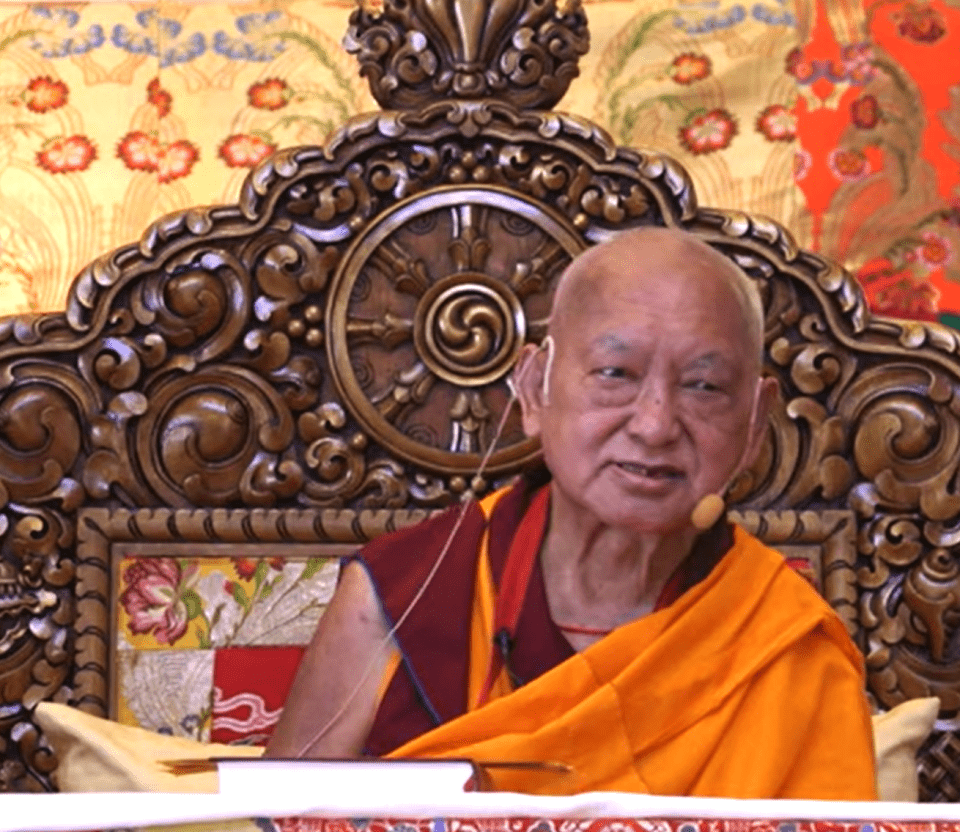
Lama Zopa Rinpoche teaching at Kopan Monastery, April 9, 2023.
Lama Zopa Rinpoche offered teachings and advice to a group of Vajrasattva retreaters at Kopan Monastery on April 7, 8, and 9, 2023. In his final teaching from this series, Rinpoche discussed how to develop one’s mind in Dharma, the necessity of practicing the lamrim, and concludes offering the oral transmission of The Essential Nectar. This was one of the last teaching events Rinpoche offered before showing the aspect of passing away on April 13, 2023.
In order to develop one’s mind in Dharma, Rinpoche advised:
“The conclusion is that we need to learn Dharma; we need to learn, reflect, meditate, and actualize the path. The whole point is to actualize the path. It’s not about just being an expert, like a professor; it’s not about knowing the words of sutra and tantra, blah, blah, blah, like snow falling, or like hailstones. It is not just that; it is about practice. Whether you know a lot about Dharma, an average amount, or only a little, you must practice; you must subdue your mind.
“So, how do you begin to practice Dharma? By meditating on impermanence and death. How do you subdue your mind? By meditating on the impermanence and death. That’s how you start. Once you have that, everything happens; everything then comes in your mind. There’s no separation between your mind and Dharma. In this way your mind itself becomes Dharma.”
The one answer is to practice lamrim, Rinpoche explained:
“If you want to make your life really fruitful, really meaningful, the one answer is to practice lamrim. Otherwise, your life is spent in hallucination. There are many different levels of hallucination. Your life is spent in distraction, with attachment and anger, but especially with attachment. Like that, your life is spent in distraction, in hallucination. …
“Even if you’re working, even if you have to do a job to make money, your motivation should be to benefit sentient beings, to serve sentient beings. Do you understand? You should be humble and respectful with your body, speech, and mind. You should be kind to everyone, even those who criticize or harm you. You should be humble, kind, polite, and serve others with your body and speech. It makes people so happy when you speak politely to them. With holy objects, you have a mind of devotion, but with sentient beings, you should have compassion.”
Rinpoche continues, and concludes, the oral transmission of The Essential Nectar, starting at 1:27:52 of this video.
We invite you to go deeper into the topics presented here, plus many others, by watching Rinpoche’s video below and reading the full transcript of Rinpoche’s teaching.
- Read the transcript of Rinpoche’s teaching.
- Find links to resources to support your Vajrasattva practice in the Foundation Store.
Teachings offered by Lama Zopa Rinpoche to the 2022 Vajrasattva retreatants at Kopan Monastery:
Read a letter from Lama Zopa Rinpoche to a student who offered 100,000 Vajrasattva mantras to Rinpoche:
Lama Zopa Rinpoche was the spiritual director of the Foundation for the Preservation of Mahayana Tradition (FPMT), a Tibetan Buddhist organization dedicated to the transmission of the Mahayana Buddhist tradition and values worldwide through teaching, meditation and community service.
For more video teachings of Lama Zopa Rinpoche please visit:
fpmt.org/media/streaming/teachings-of-lama-zopa-rinpoche
8
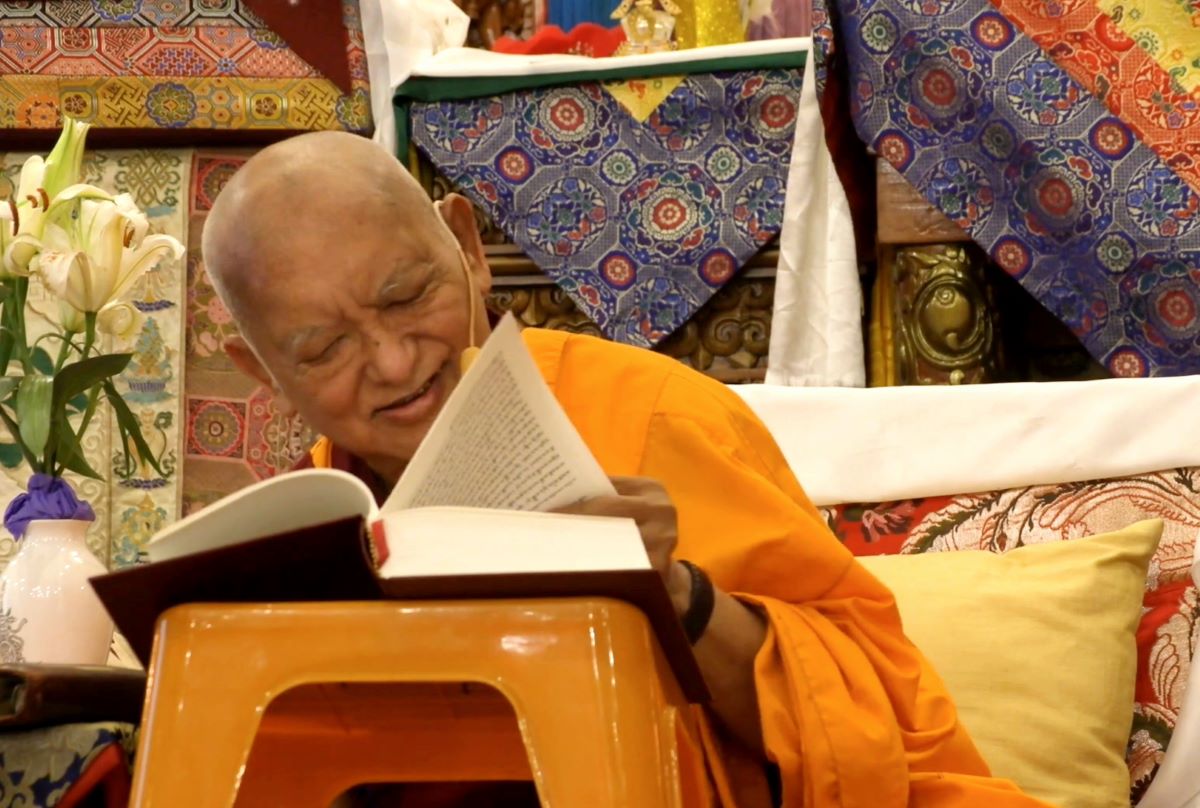
Lama Zopa Rinpoche teaching at Kopan Monastery, April 8, 2023.
Lama Zopa Rinpoche offered teachings and advice to a group of Vajrasattva retreaters at Kopan Monastery on April 7, 8, and 9, 2023. In his second teaching from this series, Rinpoche discussed the benefits of purification practice, the necessity of pleasing and receiving the blessings of the guru, the importance of meditating on death and impermanence, and continues offering the oral transmission of The Essential Nectar. This was one of the last teaching events Rinpoche offered before showing the aspect of passing away on April 13, 2023.
Mediation on impermanence and death is the most important mediation, Rinpoche stressed:
“You have to be careful with this life, This life has to be the best! You have to live the best, to do everything the best, because a human life is received just about one time. In a human life, you don’t know what will happen. You might think, ‘Oh, I will live for many, many years,’ but your life can be stopped at any time. You can’t say whether it will last even today. You can’t say whether you can still be a human being tomorrow or not. There are many people who will die tonight. Tomorrow morning, when it’s time to wake up, their body is a dead body.
“This will happen to many people tonight. It’s not sure whether you will be in that group. So many people alive today will be dead this year, this month, this week, tomorrow, or even tonight. It’s not sure—you can be dead at any time. I mean, you go to the bathroom, but it’s not sure you can come back. You can go to the kitchen to eat food, but it’s not sure you can come back. You can go to sleep, but it’s not sure you can wake up. It’s like this with everything. Everything. You can’t really tell. Death can happen in any moment. This is the reality. If you check, this is the reality. Impermanence and death can happen at any time. In Buddhism, meditation on impermanence is most important. Meditation on impermanence and death is what makes you begin to practice Dharma, to continue to practice Dharma and achieve realizations of the path, and to complete your Dharma practice. You have to keep this in mind.”
Ignorance doesn’t help death, Rinpoche explained:
“Because most people haven’t met Dharma, they’re ignorant. They try not to think about death, try to block it out, but that doesn’t help. When death comes, the first suffering is separating from the family. People have so much attachment to “my family, my wife.” Second is “my possessions.” Third is “my body,” which has been cherished most, more than all the sentient beings. The first thing is this. They try to ignore death, but that doesn’t help. You have unbelievable suffering.
“They don’t believe in a next life, then the next life comes. Even though, intellectually, they don’t believe in reincarnation, some people intuitively feel that some bad, heavy thing is going to happen after this life. There are people who naturally feel this. There are such people—I’ve met them. Even though, intellectually, you think there’s no reincarnation, but you naturally feel that something very bad is going to happen to you.
“So, when you think of next lives, it’s another world. Since you lived your life with a selfish mind, everything is negative. All your life you harm others, and harm to others means harm to yourself. Your whole life you harm others with your body, speech, and mind—cheating others, killing others—to get happiness and power for you and for your family. If you become the prime minister or president, the whole population becomes upset with you, because you have not looked after their happiness, and everybody protests.”
While continuing to offer the oral transmission of The Essential Nectar (starting at 54:40 in this video), which Rinpoche started the day prior, he stopped to discuss the importance of imprints:
“Imprints are very, very important. If we always think negative things in our life, our mind gets used to those negative things, and negative imprints are left on our mind all the time. What is advertised in the West by businesses in order to make money develops attachment, self-cherishing thought, and so forth. They are advertising objects of attachment. In the West, what is advertised is all the objects to which we’re most attached. They try to advertise in the best way and that’s what people buy. However, watching that and thinking of that leaves negative imprints on the mind. And so much negative imprint affects this life, and then life to life. The negative imprints that are left affect this life, then life to life for eons and eons. That is the wrong effect not the right effect. …
“You have to know how important positive imprints are in making preparation in the mind for enlightenment, for omniscience. They are so important. This mind, which is formless, colorless, shapeless, but able to perceive objects, can create hell, can create samsara, can create nirvana, can create enlightenment. This mind has that potential, negative and positive.”
We invite you to go deeper into the topics presented here, plus many others, by watching Rinpoche’s video below and reading the full transcript of Rinpoche’s teaching.
- Read the transcript of Rinpoche’s teaching.
- Find links to resources to support your Vajrasattva practice in the Foundation Store.
Teachings offered by Lama Zopa Rinpoche to the 2022 Vajrasattva retreatants at Kopan Monastery:
Read a letter from Lama Zopa Rinpoche to a student who offered 100,000 Vajrasattva mantras to Rinpoche:
Lama Zopa Rinpoche was the spiritual director of the Foundation for the Preservation of Mahayana Tradition (FPMT), a Tibetan Buddhist organization dedicated to the transmission of the Mahayana Buddhist tradition and values worldwide through teaching, meditation and community service.
For more video teachings of Lama Zopa Rinpoche please visit:
fpmt.org/media/streaming/teachings-of-lama-zopa-rinpoche
6
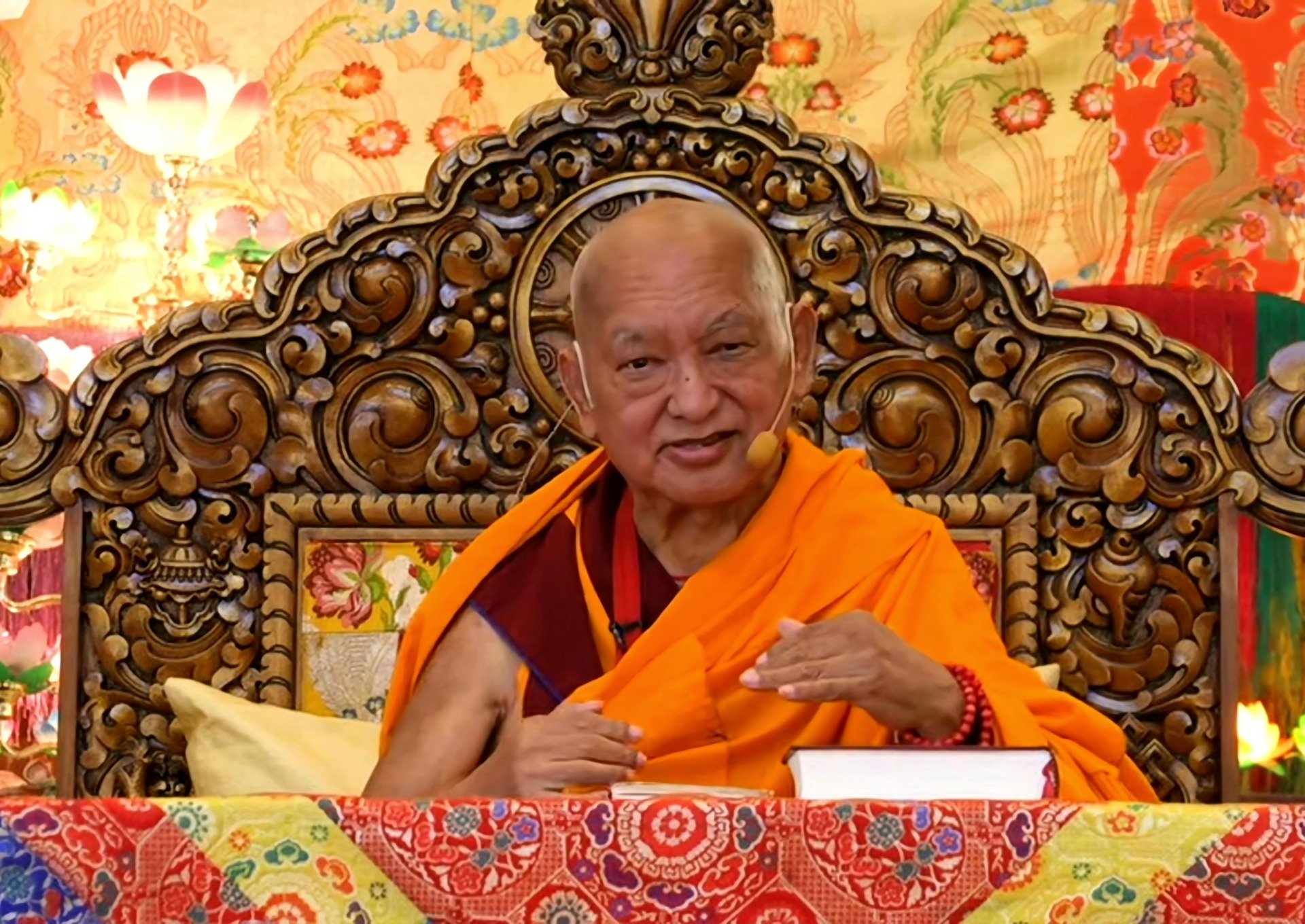
Lama Zopa Rinpoche teaching at Kopan Monastery, April 7, 2023.
Lama Zopa Rinpoche offered teachings and advice to a group of Vajrasattva retreaters at Kopan Monastery on April 7, 8, and 9, 2023. In his first teaching from this series, Rinpoche overviewed some of the many benefits of purification practice. This was one of the last teaching events Rinpoche offered before showing the aspect of passing away on April 13, 2023.
Addressing the retreatants Rinpoche said:
“There are so many problems in the world—what should we do? Doing Vajrasattva practice is the answer; doing purification is the answer. You are purifying negative karma, from where all the sufferings came. Purification is the answer to war, famine, disease, and the dangers from fire, water, earth, and air. That is the answer. So, you’re doing the right thing; you’re doing the most important thing. I want to say that. So many people ask, “What can I do?” You didn’t make any mistake. This time you made the best decision. I want to say that.”
We are our own guide, and our own enemy, Rinpoche explained:
“When your mind becomes pure, when your mind becomes holy Dharma, at that time you become the guide to yourself. Whenever your mind becomes non-Dharma, non-virtue, you then become the enemy to yourself. When your mind is in anger, you are the enemy to yourself; you destroy yourself. When you’re ignorance, when you’re attachment, clinging to this life, you are the enemy to yourself; you destroy yourself. When your mind becomes self-cherishing thought, you then destroy your enlightenment. It not only hinders you to achieve happiness for yourself, but it hinders you to benefit others, the numberless sentient beings. So, when your mind becomes self-cherishing thought, you become the enemy to yourself.
“When you are without ignorance, anger, and attachment, your mind then becomes Dharma, When your mind becomes bodhichitta, the good heart wishing to help others, to benefit others, at that time you become the guide to yourself.
“When you see the reality that samsara and samsaric happiness is suffering, you then have renunciation. With that renounced mind, with that satisfaction and contentment, you then become the guide to yourself.
“When your mind becomes attachment, seeking samsaric perfections, you then become the enemy to yourself.
“When your mind becomes bodhicitta, you then create the cause to achieve enlightenment and to enlighten all sentient beings. At that time you become the best guide to yourself.”
Without doing Vajrasattva practice, negative karma multiplies day by day, Rinpoche warned:
“Without reciting the hundred-syllable Vajrasattva mantra at all, any negative karma you have done with your body, speech, or mind multiplies day by day. On the second day it becomes double, on the third day it multiples by four times. It increases and increases in this way. If you don’t recite the Vajrasattva mantra at all, that one negative karma you collected with your body, speech, or mind, by increasing day by day, becoming like a mountain when you die. …
“By multiplying, one atom increases to become like a mountain; like that, one negative karma becomes like a mountain when you die. Then, in one day, you create so many negative karmas with your body, speech, and mind, and each one becomes like a mountain. Can you imagine? Then, for eons and eons, you wander in the lower realms and suffer for all that. It’s almost like it’s not possible for you to be born as a human being or in the deva realm, and no way for you to meet Dharma. Therefore, you understand how important doing Vajrasattva practice and other purification practices is. If you do 100,000 Vajrasattva mantras, even if you broke a pratimoksha vow or tantric root vow, it totally purifies it.”
Pleasing the guru is the best purification, and the best way to collect merit, Rinpoche advised:
“The best way to collect the greatest merit and to perform the greatest purification is by pleasing the guru. Not just any guru in the world—the guru from whom you have received teachings and whom you regard as your guru. To please that guru, by fulfilling their wishes and following their advice, is the most important thing for you to achieve enlightenment in the quickest away. That is the essence.
“Vajrasattva practice is so important. I want to thank very, very much everyone who is sacrificing your precious time, your precious human life, but especially the Vajrasattva people. You are doing it not only for your happiness, but for the happiness of all sentient beings.”
Rinpoche began offering the oral transmission of The Essential Nectar at 1:17:00 in this video.
We invite you to go deeper into the topics presented here, plus many others, by watching Rinpoche’s video below and reading the full transcript of Rinpoche’s teaching.
- Read the transcript of Rinpoche’s teaching.
- Find links to resources to support your Vajrasattva practice in the Foundation Store.
Teachings offered by Lama Zopa Rinpoche to the 2022 Vajrasattva retreatants at Kopan Monastery:
Read a letter from Lama Zopa Rinpoche to a student who offered 100,000 Vajrasattva mantras to Rinpoche:
Lama Zopa Rinpoche was the spiritual director of the Foundation for the Preservation of Mahayana Tradition (FPMT), a Tibetan Buddhist organization dedicated to the transmission of the Mahayana Buddhist tradition and values worldwide through teaching, meditation and community service.
For more video teachings of Lama Zopa Rinpoche please visit:
fpmt.org/media/streaming/teachings-of-lama-zopa-rinpoche
- Tagged: lama zopa rinpoche, purification, vajrasattva
30
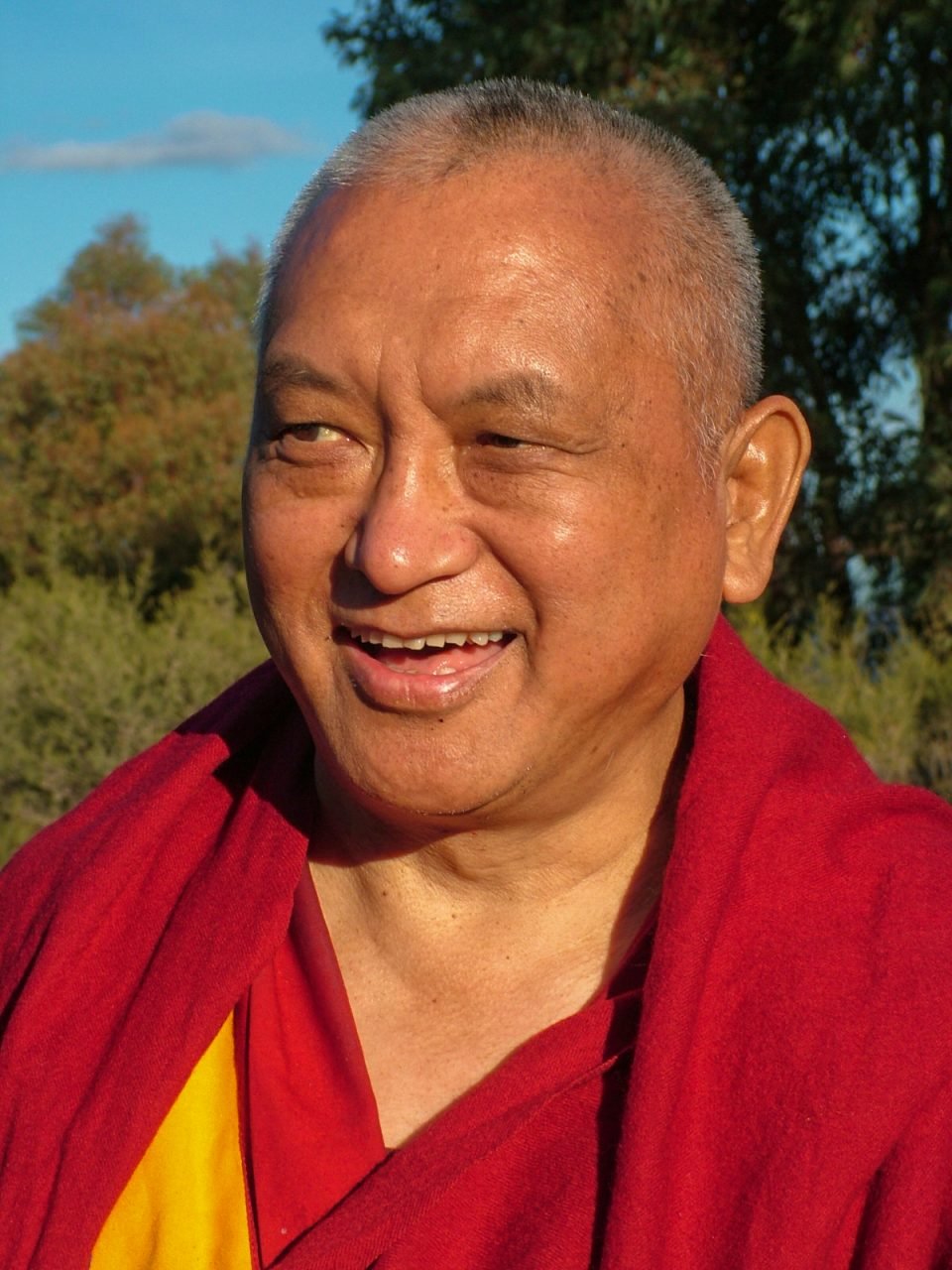
Lama Zopa Rinpoche in Australia, June 2006. Photo by Ven. Roger Kunsang.
Lama Zopa Rinpoche’s care for animals is legendary, and he used every opportunity to bless and benefit sentient beings of all shapes and sizes, wherever he traveled. In this 9 minute video of Rinpoche offering an animal blessing in Australia in 2006, we can enjoy a short teaching from Rinpoche about the benefits of offering Dharma imprints to animals, with so many fortunate (and adorable!) furry and feathered creatures present. We can also take comfort in Rinpoche’s infectious laughter and the joy of such a gathering, made even more so by the uplifting song, “How Great it Would Be” by George Galt playing in the background.
You can read a recent collection of the extensive advice that Lama Zopa Rinpoche has offered about benefiting animals:
fpmt.org/edu-news/wish-fulfillment-for-all-animals
Please also visit our webpage, Benefiting Animals: Practices and Advice, which contains many resources for those wishing to benefit animals in the most extensive ways possible:
https://fpmt.org/education/prayers-and-practice-materials/benefiting-animals-practices-and-advice
Foundation for the Preservation of Mahayana Tradition (FPMT), is a Tibetan Buddhist organization dedicated to the transmission of the Mahayana Buddhist tradition and values worldwide through teaching, meditation and community service.
22
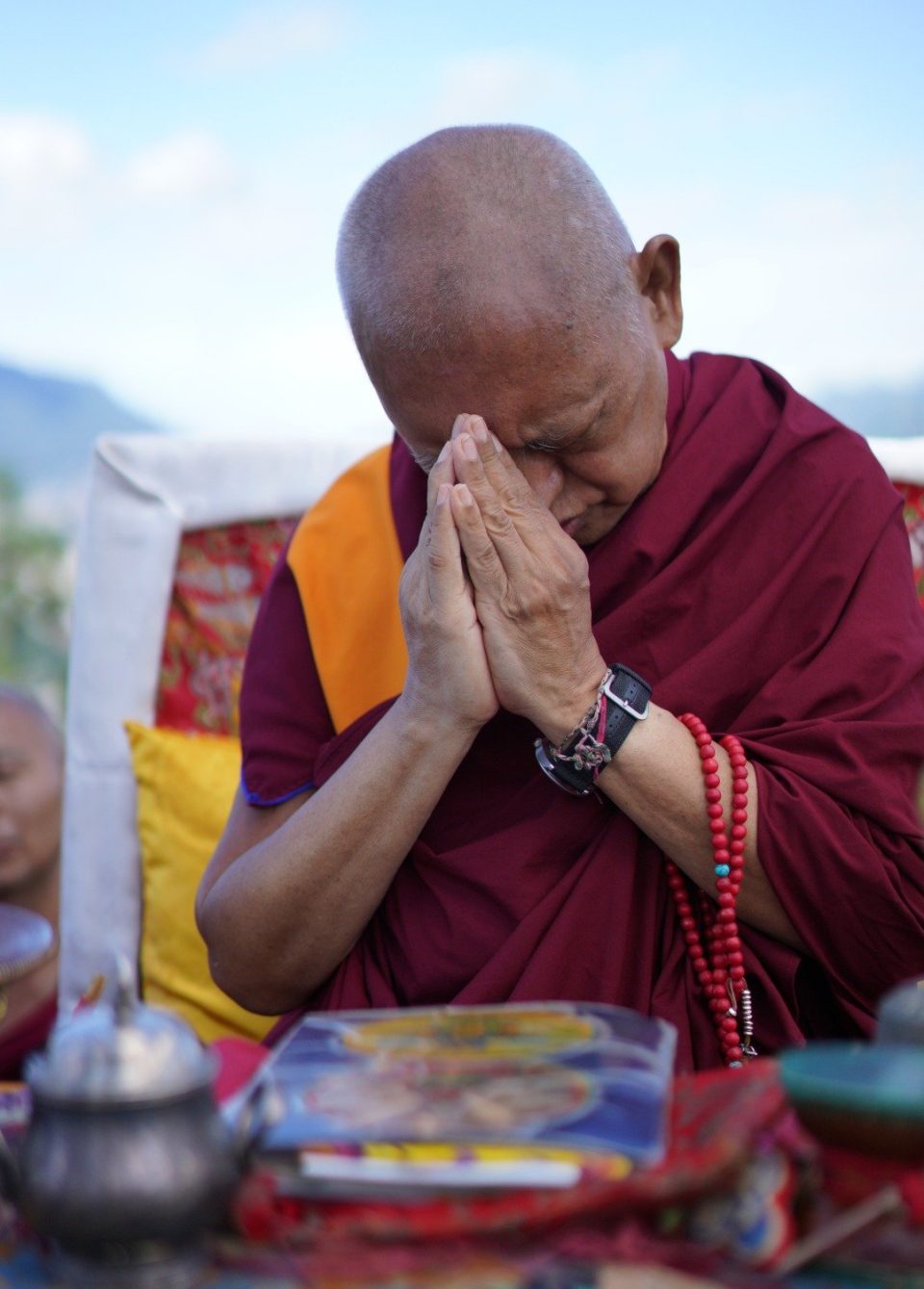
Lama Zopa Rinpoche, Kopan Monastery, 2020. Photo by Ven. Lobsang Sherab.
In this short yet powerful advice, Why the Guru Shows the Aspect of Making Mistakes, Lama Zopa Rinpoche discussed some of the key points of the practice of guru devotion, focusing on the concept of tshul, “showing the aspect”: because buddhas need to manifest in ordinary forms to teach us their behavior can appear unenlightened or mistaken. In other words, they “show the aspect” of making mistakes for our sake.
About this advice, Rinpoche said: “This is my gift, a more important, more precious gift than the whole sky filled with gold, diamonds, and wish-fulfilling jewels.”
Lama Zopa Rinpoche elucidates the topic of guru devotion extensively in The Heart of the Path: Seeing the Guru as Buddha which was drawn from nearly fifty teachings given over three decades and includes commentary on the traditional guru devotion teachings found in the lam-rim, practical advice on guru devotion, and inspiring stories of past guru-disciple relationships, as well as extensive commentary on the practice of guru yoga.
“Without guru devotion, nothing happens-no realizations, no liberation, no enlightenment-just as without the root of a tree there can be no trunk, branches, leaves or fruit. Everything, up to enlightenment, depends on guru devotion.”
https://shop.fpmt.org/Heart-of-the-Path-eBook-PDF_p_2360.html
https://www.lamayeshe.com/article/chapter/heart-path
- Tagged: guru devotion
18
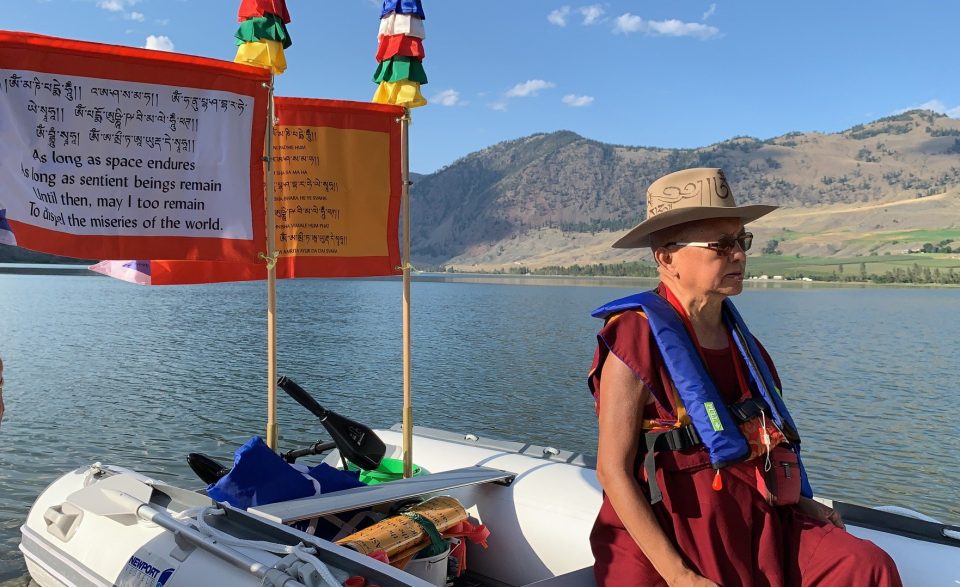
Lama Zopa Rinpoche with mantra cowboy hat blessing the sentient beings in a lake in Washington, USA with mantras, blessed food, sutra recitation, visualization, and prayers, August 2019. Photo by Ven. Holly Ansett.
We are so fortunate that Lama Zopa Rinpoche left us with many opportunities to benefit from his teachings and advice. In this short impromptu video clip from 2009, Rinpoche shares a meditation on emptiness on top of a rock in Washington state, USA. The day before, a student had offered Rinpoche a cowboy hat, which Rinpoche wore as the sun set and moon rose.
We have archived many short videos of Lama Zopa Rinpoche which are very inspiring, moving, and sometimes very humorous, available here: fpmt.org/media/streaming/videos-of-lama-zopa-rinpoche
Foundation for the Preservation of Mahayana Tradition (FPMT), is a Tibetan Buddhist organization dedicated to the transmission of the Mahayana Buddhist tradition and values worldwide through teaching, meditation and community service.
- Tagged: emptiness, lama zopa rinpoche
10
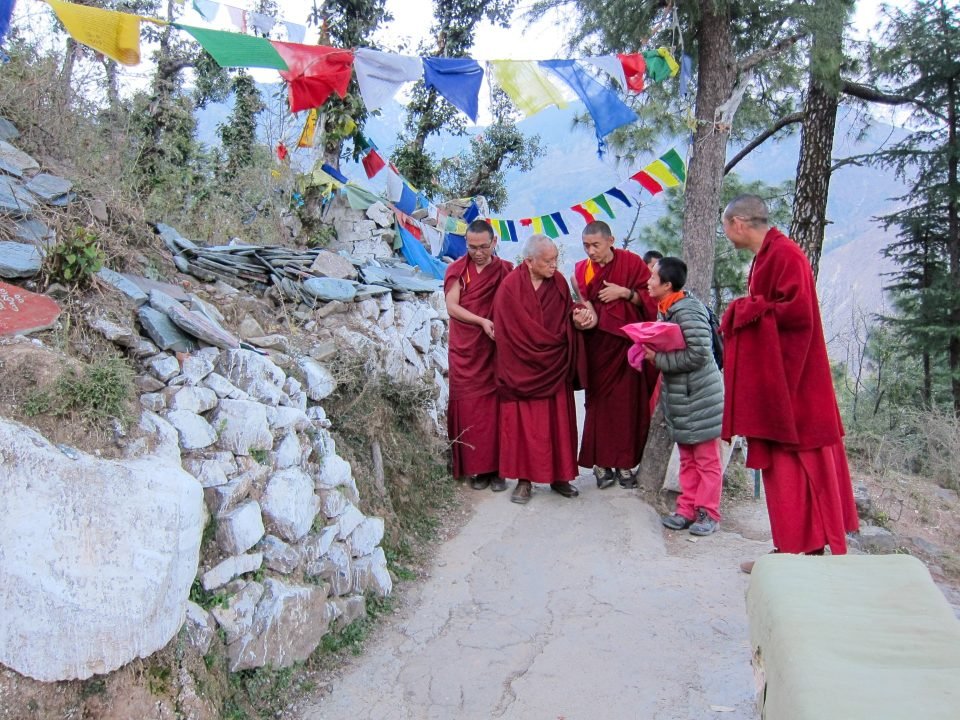
Lama Zopa Rinpoche in Dharamsala, 2012. Photo by Ven. Roger Kunsang.
Over the years, while traveling continuously with Lama Zopa Rinpoche, Ven. Roger Kunsang, CEO of FPMT and Rinpoche’s long-time attendant, would share stories of what it was like to be on the road with Rinpoche, and to witness and participate in Rinpoche’s enlightened activity. These stories offer a glimpse into how Rinpoche used all of the circumstances in daily life, including the time traveling, to practice Dharma and serve others. In 2012, Ven. Roger shared this story from the road in Dharamsala, India:
It’s very dark. There is a strong storm with blasting winds and the road is narrow with room for only one vehicle at a time. The road is on the edge of a cliff at least a 1,000-foot [305-meter] drop on one side – it makes you dizzy looking over the edge. The road is in bad condition: sometimes just gravel and rock, with too many holes really jarring the car. There is a truck coming the other way heading straight for us blasting its horn. (Indian trucks are big and heavy and often held together by wood! They are actually huge pieces of scrap metal on wheels with tires that have no tread or very little.) I have nowhere to go (it’s me driving) and I can’t figure how to avoid this oncoming scrap metal heap on wheels that moves like a crab. The roads are so narrow so when an oncoming vehicle appears, you have to find quickly where the road is a little wider so you can pass each other, otherwise you get stuck and someone has to reverse up. And even then it could be a long way and then you might find another car behind you and he is blasting his horn and the car behind him is blasting away on his horn. Actually, Indian drivers drive with one hand on the wheel and the other on the horn, and it is very acceptable. Anyway, I manage very luckily to find a place where we can pass and we continue in complete darkness. The journey is 12 hours so you really have to be alert all the time, like really alert!
Everyone has the right-of-way on the roads which is confusing, everyone thinks they own the road which also goes for pedestrians, cows, dogs and donkeys … earlier in the day we came across a guy on the phone rolling with his feet a large gas bottle down the middle of the road, the gas bottle picked up speed and he lost control which didn’t seem to be a problem for him as he continued talking on the phone as the gas bottle picked up more speed and headed straight for us! We swerved and all was fine as it is with Indian roads as there are no rules so no one is doing anything wrong so all is OK … I like it with no rules, but can’t handle the overtaking on blind curves, which is common. (I thought it appropriate to have no full stops when describing the roads here.)

Manikaran. Photo by John Hill. Creative Commons (Wikipedia)
Later that night we came across two trucks that just had had a head-on crash. There was no room to pass each other, so I guess they couldn’t get around each other so they decided to go through each other. It is very messy. Trying to get past this mess and not disappear over the edge of the cliff created some anxious moments. This is the drive to Manikaran from Dharamsala, where Rinpoche went for treatment in the hot springs.
It was a nice relaxing time with plenty of time to go to the hot springs, a holy place of Guru Nanak of the Sikh tradition. Still, Rinpoche’s focus seemed to be on others and we never had enough time to actually go to the hot springs apart from slipping in one short session here and there. Rinpoche instead focused on the local Tibetan community about four hours’ drive away (yes, on the worst roads ever). The community (near Manali) is where Song Rinpoche’s mother lived before coming to the US. A few years before Rinpoche had sponsored the main statues on the altar of the small gompa there. Rinpoche visited the place a couple of times and wants to have eight monks there and a proper small monastery, so Rinpoche made a proposal to the community to sponsor and set it up. Another time we visited this beautiful and amazing Kagyü temple not far away. Rinpoche was interested in the art and architecture. Then 12 hours back to Dharamsala again via the Tibetan community in Manali.
Now we are packed and ready to leave for Dehradun, about 10 hours’ drive from here. We should leave now but Rinpoche is still teaching (in the gompa of Tushita). We were supposed to leave yesterday, but didn’t. I already forgot why. Now waiting … hopefully, Rinpoche will finish soon. I’m so keen to get back on the Indian roads with no rules. No rules does make it easy.
Practices for Auspicious Travel
All are welcome to download various practices which Lama Zopa Rinpoche has recommended for clearing obstacles while engaged in travel, here are a few of these recommended practices:
- An Extremely Abbreviated Version of The Exalted Sutra ”Completely Dispelling the Darkness of the Ten Directions”
- Dharani Which Accomplishes All Aims
- A Ritual to Perform When Undertaking Activities on Inauspicious Days
- Tea Offering to the Eight Classes (De gyä) in the Protector Prayers
- Noble Stack of Auspiciousness
Foundation for the Preservation of Mahayana Tradition (FPMT), is a Tibetan Buddhist organization dedicated to the transmission of the Mahayana Buddhist tradition and values worldwide through teaching, meditation and community service.
8
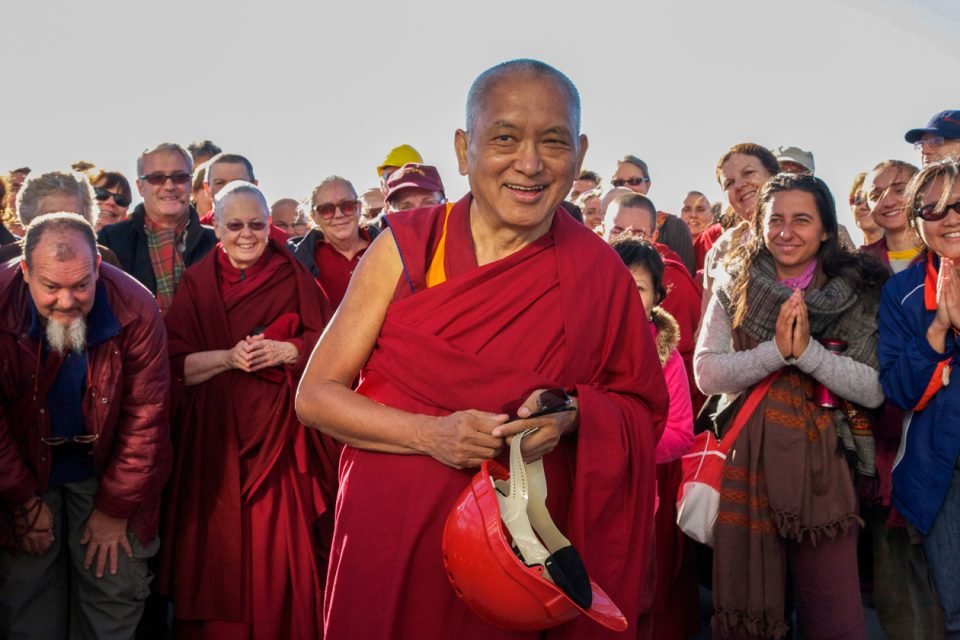
Lama Zopa Rinpoche at the Great Stupa of Universal Compassion, Bendigo, Australia, April 2011. Photo by Ven. Roger Kunsang.
Lama Zopa Rinpoche discussed reincarnation in this archival video clip. During a quiet moment at the April 2011 retreat at the Great Stupa of Universal Compassion near Bendigo, Australia, Rinpoche gave an informal talk that was recorded by Ven. Thubten Kunsang, who traveled with Rinpoche, recording Rinpoche’s teachings and taking photos. The video was recorded before Rinpoche manifested a stroke at the retreat. Here’s a summary of the video:
Rinpoche began this teaching by explaining that when someone dies, their body disintegrates and becomes dust, but their mind doesn’t stop. Their mind continues.
Rinpoche then offered the example of a family with children from the same mother. Some of the children in the family may be very intelligent or very compassionate, but sometimes there might also be a child who is very foolish and ignorant. One child may cry if they see someone else being beaten or even an insect being killed. That child can’t stand seeing others hurt and cries because of their compassion. And then, from the same mother, there may be one child who doesn’t care about this and maybe themselves want to kill.
Rinpoche explained that this shows that the minds of the different children didn’t come from the mother’s mind. The mind has its own continuity and is settled upon the body. The body of a child comes from their parents. But their mind doesn’t come from the parents. The mind has its own conditions from before.
So if in a past life one was more compassionate, the mind was trained in that, and the result is that in this life, they are compassionate, Rinpoche explains. Similarly if one was more angry in a past life, then the mind was trained or habituated to anger, which describes the result in this life. So there’s a cause from before a child takes birth in the mother’s womb that has a consequence in the present life. In past lives there were certain negative actions done, which polluted the mind. And so then there’s the result of that.
Rinpoche then talked about a book that he has in which a professor collected examples of children and older people who could remember their past lives. These are people in the West, but their stories are hidden and not part of the culture. They were discouraged from sharing their stories. Then there are people who can see other people’s past and future lives.
However, Rinpoche explained, there’s nobody who discovered or who realized that there’s no past and future lives and that there’s no reincarnation and karma. There’s nobody who has discovered or realized there is only one life. Many people have just assumed this or were taught this, but there’s nobody who realized this. Rinpoche concluded by explaining that those who have realized past and future lives are numberless.
You can watch the video “Lama Zopa Rinpoche on the Topic of Reincarnation, April 2011”:
Foundation for the Preservation of Mahayana Tradition (FPMT), is a Tibetan Buddhist organization dedicated to the transmission of the Mahayana Buddhist tradition and values worldwide through teaching, meditation and community service.
- Tagged: lama zopa rinpoche, reincarnation
4
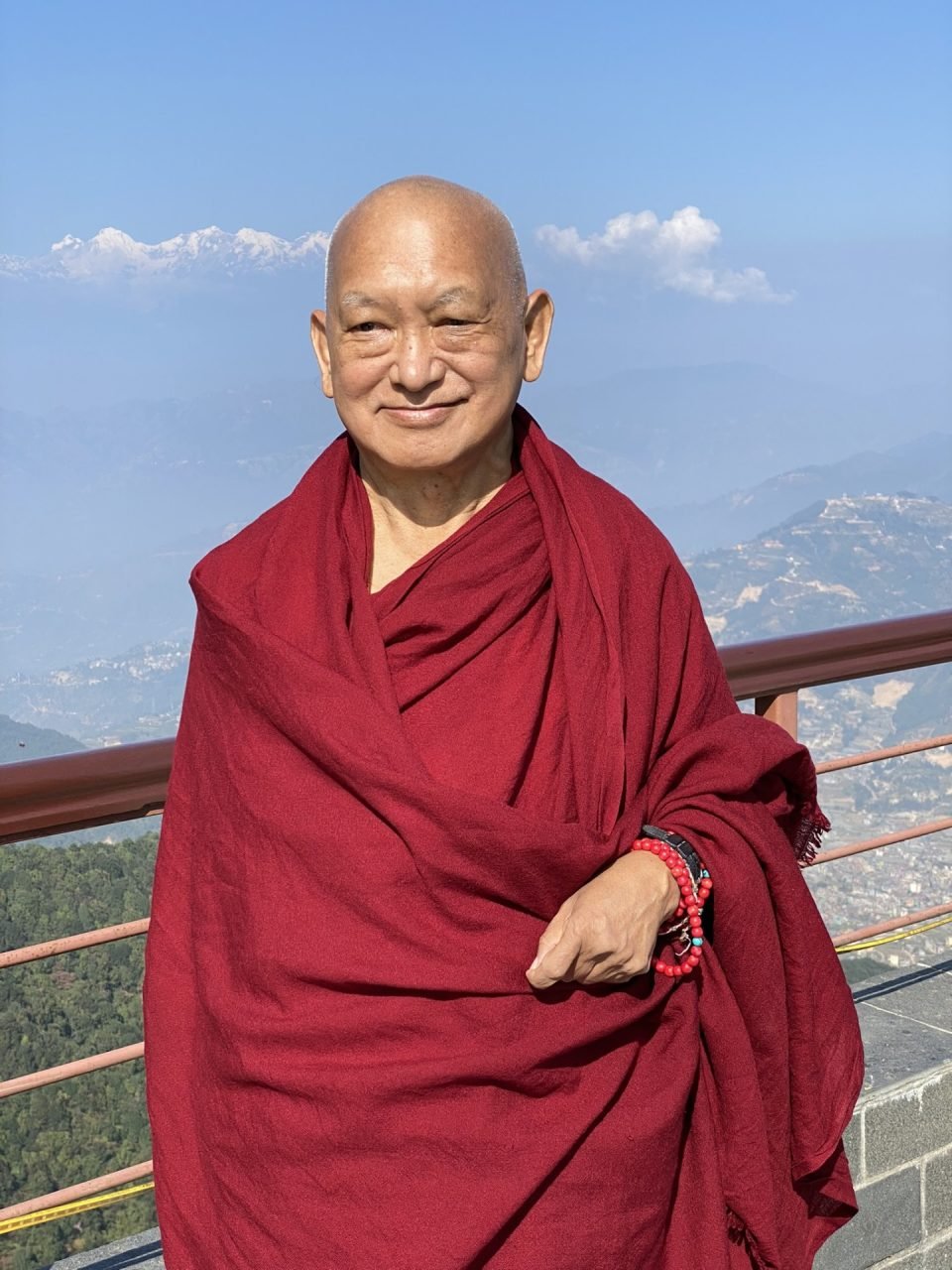
Lama Zopa Rinpoche in Kathmandu, Nepal, November 2021. Photo by Ven. Roger Kunsang.
No matter where we live in the world, facing severe conditions resulting from the weather or natural disaster effects us all. Every year, hundreds of disasters of the elements occur around the world due to drought, floods, extreme weather, extreme temperature, landslides, dry mass movements, wildfires, volcanic activity, and earthquakes.
For example, recently Centro Muni Gyana, the FPMT center in Palermo, Italy, was surrounded by flames due to wildfires in Sicily at the end of July. Incredibly, the fire was burning around the center but stopped right before the stupas that had been built on the center’s property according to Lama Zopa Rinpoche’s recommendation.
As another example of the universality of natural disasters, severe flooding in Vermont, US, devasted several towns close to Milarepa Center but fortunately the center suffered only minor damage including fallen trees.
Lama Zopa Rinpoche discussed this in a letter to a student who lived in an area prone to hurricanes:
“Whatever problems there are can be made less, and even completely stopped, if someone takes strong refuge and prays to even just one buddha. The weather can change in that very hour by the power of one person making prayers. There is no question that if the person who makes the prayers has realizations, such as the realization of bodhicitta, which is actually the best realization, then every single prayer has incredible power. There are stories of many bodhisattvas and great saints in the past who were able to prevent floods, change the direction of rivers, stop them altogether, and walk across them to the other side.”
And further, Rinpoche explained in advice for dealing with intensely hot conditions:
“The foundation of Buddhism is that happiness and suffering come from the mind, from your mind. So your mind is the creator. It’s explained in Abidharmakosha, this is one important subject to study. The various worlds came from the mind, born from the mind. It’s either so hot, or there are landslides or earthquakes. These outside conditions are caused by non-human beings. But that’s not the main cause. The main cause is karma. Karma is the mind; it is not the body.”

Centro Muni Gyana, the FPMT center in Palermo, Italy, was surrounded by flames due to wildfires in Sicily at the end of July. Thankfully, while a terrifying image, the center did not suffer considerable damage in this disaster.
The following practices have been advised by Lama Zopa Rinpoche for mitigating severe weather conditions:
1. Protector prayers, especially “Tea Offering to the Eight Classes” (Degye Serkyem) (page 28)
2. The Prayer to Guru Rinpoche that Spontaneously Fulfills All Wishes (Sampa Lhundrupma)
Additionally advice for various types of natural disasters from Lama Zopa Rinpoche can be found on the advice page on FPMT.org
and on the Lama Yeshe Wisdom Archive
Foundation for the Preservation of Mahayana Tradition (FPMT), is a Tibetan Buddhist organization dedicated to the transmission of the Mahayana Buddhist tradition and values worldwide through teaching, meditation and community service.
31
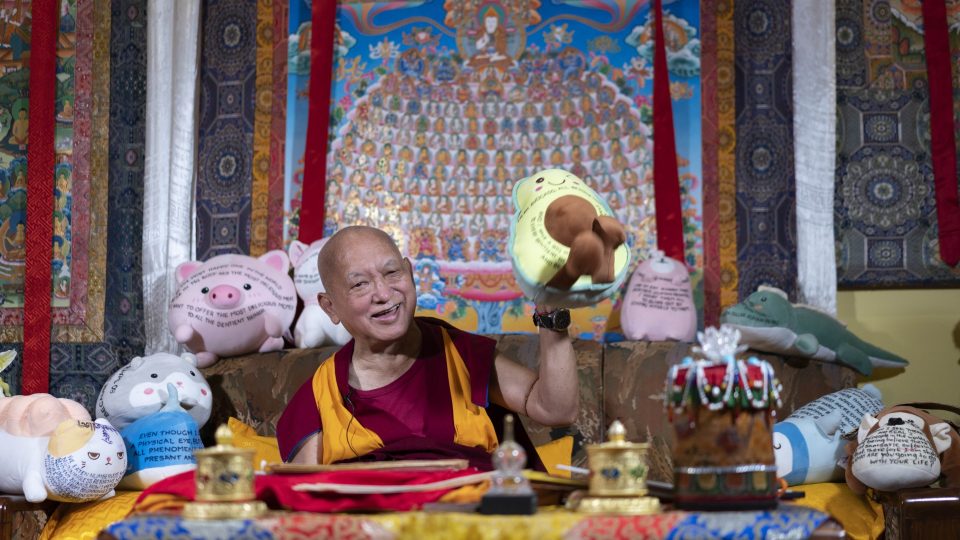
Lama Zopa Rinpoche with many of his stuffed Dharma animal friends, Kopan Monastery, Nepal, November 2020. Photo by Ven. Lobsang Sherab.
Rinpoche began this teaching, given on November 6, 2020, reminding us that the I does not exist from its own side, because it is a dependent arising. The I has been appearing to our minds as if it exists from its own side since beginningless rebirths, and we have held on to that mistaken view. But it does not exist at all like this, it’s a total hallucination.
In fact, Rinpoche added, all phenomena of samsara and nirvana do not exist from their own side because they are dependent arisings.
Rinpoche discussed the meaning of ten drel and ten jung. Ten means “depends on” or “depends to” so this eliminates eternalism. Jung is “arising,” drel is “connected.” “By depending on others, it arises.” So, “there is no existence at all from its own side.” Because it arises, this eliminates nihilism.
Rinpoche stressed that we have to practice mindfulness all day and night to see that what appears to be real has actually never existed from its own side. When we are not aware of this mistaken view, then the I and all other phenomena appear to us as real. When you believe that those appearances are true, then the self-cherishing thought—the ignorance holding the I as real—and all the delusions arise. Then we create karma and suffer in samsara. We have done that already from beginningless rebirths up to now. And so far, we haven’t become free from samsara. So we need to have the awareness that without depending on the base to be labeled, objects do not exist from their own side, not even an atom exists from its own side.
Following Phabongkha Rinpoche’s commentary, Rinpoche explained that an imputed phenomenon needs to have three attributes:
- It is renowned to a conventional mind;
- It is not harmed by another conventional valid mind; and
- It also is not harmed by the reasoning analyzing the ultimate.
Rinpoche then explained the three attributes, beginning at 44:42 in the video.
We invite you to go deeper into the topics presented here, plus many others, by watching Rinpoche’s video and reading the full transcript of Rinpoche’s teaching.
Watch Lama Zopa Rinpoche’s teaching “The Whole World Exists in Nothing More Than Mere Name”:
Watch more videos from Lama Zopa Rinpoche’s thought transformation teaching series and find Rinpoche’s teachings translated into Spanish, Italian, French, Chinese, and Russian
Foundation for the Preservation of Mahayana Tradition (FPMT), is a Tibetan Buddhist organization dedicated to the transmission of the Mahayana Buddhist tradition and values worldwide through teaching, meditation and community service.
24

Lama Zopa Rinpoche teaching during the November Course, Kopan Monastery, December 2018. Photo by Ven. Lobsang Sherab.
During the 2018 November Course at Kopan Monastery, Lama Zopa Rinpoche outlined how to reach enlightenment based on the lamrim and the importance of studying it. Rinpoche emphasized that merely knowing the lamrim is not enough; it needs to be applied in daily life. Here’s an excerpt from Rinpoche’s teachings.
Practice mindfulness and the three principal aspects of the path to enlightenment—renunciation, bodhicitta, and right view. Then everything done with renunciation becomes the cause of liberation and does not become the cause of samsara. Then everything done with bodhichitta becomes the cause of enlightenment. Then with right view, everything becomes a remedy to samsara, a remedy to ignorance, which is the root of all your suffering, your samsara, the root of all your sufferings of samsara. It eliminates that; that’s what you need.
If you don’t like suffering, you have to put in effort to actualize emptiness, if you don’t like suffering. If you don’t like depression, if you don’t like any suffering, even diarrhea, whatever you don’t like, then you need to meditate on emptiness, and in particular you have to put effort into realizing emptiness. Study emptiness, all the extensive philosophy teachings, then lamrim, the essence, the short teachings, very important teachings.
You need to not only study—you leave it up to the intellect, you leave it up to the tape recorder, you invest so much information, you put in a tape recorder or computer—not like that. You invest in your brain so much information, but no practice, you only discuss, only to be an important professor—not like that. You need to actualize. So everything becomes practice, and through practice, you actualize. Everything becomes the antidote to your samsara, to your ignorance, which is the root of your samsara. So it eliminates the root of oceans of suffering of samsara. That’s what you need. If you don’t like suffering, you need to put effort in that. It’s extremely worthwhile.
Not only that, not only to free yourself from oceans of suffering of samsara, not only that, but with the help of bodhichitta, you collect inconceivable, inconceivable, inconceivable merits, with that support. Then with the wisdom realizing emptiness, you directly cease the obscuration, not only gross but subtle obscuration. Then you achieve enlightenment for sentient beings, and you are able to liberate all sentient beings from oceans of samsaric sufferings and bring everyone to buddhahood.
If you don’t like suffering, if you have problems—a relationship problem, a problem with the family, with the husband, with the wife or children, with friends, whatever—you should know that. The antidote—to be free from the suffering of samsara—you need to be free from delusion and karma; you need to be free from ignorance, the root of samsara. So you need to meditate on emptiness. That is what you need.
Otherwise, your problems have no end. Then you rely on psychology. It has no end, relying on psychology or psychiatry. It has no end. Your going to hospital has no end; it’s endless. Your going to hospital, having an operation on your brain, it’s endless. It becomes endless. That is the nature of samsara.
When you have problems, think: “Oh, this is a sign that I’m in samsara. This shows me. This proves it to me. It is sign that I’m in samsara. So, oh, I need to be free from samsara, so then I should practice Dharma.” It should have that as a conclusion.
The conclusion you should come to is that. To actualize Dharma, the heart of Buddhadharma—renunciation, bodhichitta, right view—you should come to the conclusion to practice lamrim. You should come to that conclusion, then that is the best.
You have something to do that is most worthwhile for you and every sentient being—every hell being, they are numberless, for everyone, to benefit every ant, every fish, every chicken, every goat, sheep, what we eat, to benefit every mosquito, every small ant, small flies, so tiny, but numberless, to everyone, to benefit, especially with bodhichitta, then, every human being, every sura being, every asura being, every intermediate state being. Then instead of depression, you have so much happiness in life, because you know what to do, you know what you should do. You know the meaning of life!
Watch the 24-minute video of Rinpoche teaching at Kopan Monastery from which this excerpt is taken:
Colophon: Excerpted from Lama Zopa Rinpoche teaching at Kopan Monastery, Nepal, December 12, 2018. Simultaneously transcribed by Ven. Joan Nicell. Lightly edited by Laura Miller, July 2019. (Complete unedited transcript here.)
Lamrim Year is an essential guide for meditators who want to develop their mind in the graduated path to enlightenment (lamrim). This unique study program provides a 365-day outline of the graduated path in a clear, practical format that is suitable for both individual and group practice. The daily quotes and text have been selected from four decades of teachings by Lama Yeshe and Lama Zopa Rinpoche, and offer a taste of their teaching style and scope: lamrimyear.com
You can access all the video teachings from Lama Zopa Rinpoche during the 2018 Kopan lamrim meditation course:
fpmt.org/media/streaming/teachings-of-lama-zopa-rinpoche/kopan-november-course-2018
- Tagged: essential extract, kopan course, lamrim year
21
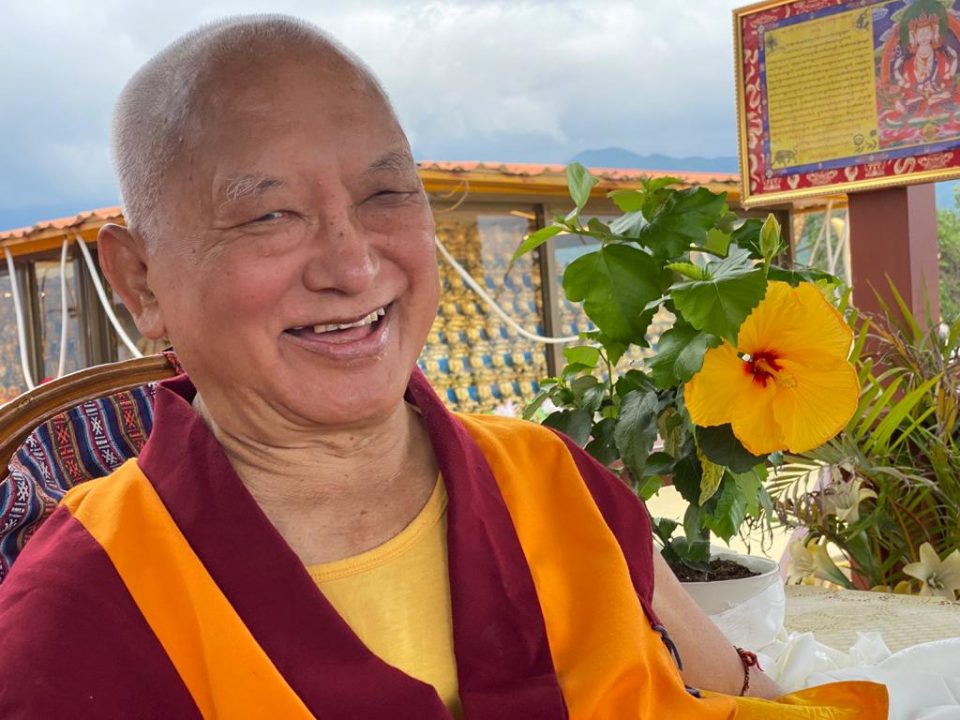
Lama Zopa Rinpoche, Kopan Monastery, Nepal, July 2020. Photo by Ven. Roger Kunsang.
In 2020 on Chokhor Duchen (celebrated this year on July 21, 2023), Lama Zopa Rinpoche offered a video teaching from Kopan Monastery as part of his thought transformation series entitled, “Wake Up– Don’t Waste the Four Holy Days of Guru Shakyamuni Buddha.”
Chokhor Duchen commemorates the anniversary of Shakyamuni Buddha’s first teaching after showing the aspect of attaining enlightenment, and is one of the holy days of Guru Shakyamuni Buddha, when the power of any meritorious action is multiplied 100 million times.
Rinpoche begins this teaching discussing the twelve deeds done by Shakyamuni Buddha, which reveal why we need to practice Dharma.
Shakyamuni Buddha gave three turnings of the wheel of Dharma: the four noble truth teachings in Sarnath; the Prajnaparamita teachings in Rajgir; and the Chittamatra view. On wheel-turning days, because merit is multiplied by 100 million, Rinpoche is asking us to “wake up” and not waste the opportunity by being distracted by worldly pleasures and worldly concerns. For example, writing sutras in gold ink is a way to collect skies of merit.
Rinpoche shares more about the benefits of the Sutra of Great Liberation, including that if you read it just before you die you are immediately rescued from the lower realms.
Watch Lama Zopa Rinpoche’s teaching “Wake Up—Don’t Waste the Four Holy Days of Guru Shakyamuni Buddha“:
A full transcript of this teaching is also available.
You can learn more about the “unimaginable benefits of the Sutra of Great Liberation which is now available in English:
https://fpmt.org/edu-news/unimaginable-benefits-the-sutra-of-great-liberation-is-now-available-in-english/
You can follow Lama Zopa Rinpoche’s advice on beneficial practices to do on Chokhor Duchen:
https://fpmt.org/edu-news/celebrate-chokhor-duchen-and-international-sangha-day-on-july-21-2023/
Read about the vast array of pujas and practices being offered by over ten thousand ordained sangha on this special day:
https://fpmt.org/charitable-activities/projects/retreats-and-practices/pf-news/offering-to-ten-thousand-sangha-and-pujas-sponsored-on-chokhor-duchen/
Watch more from the video series Lama Zopa Rinpoche’s Teachings on Thought Transformation and find links to videos in transcripts, MP3s, additional practice advice, and more:
https://fpmt.org/fpmt/announcements/resources-for-coronavirus-pandemic/advice-from-lama-zopa-rinpoche-for-coronavirus/
- Tagged: chokhor duchen, sutra of great liberation
- Home
- News/Media
- Study & Practice
- About FPMT Education Services
- Latest News
- Programs
- New to Buddhism?
- Buddhist Mind Science: Activating Your Potential
- Heart Advice for Death and Dying
- Discovering Buddhism
- Living in the Path
- Exploring Buddhism
- FPMT Basic Program
- FPMT Masters Program
- FPMT In-Depth Meditation Training
- Maitripa College
- Lotsawa Rinchen Zangpo Translator Program
- Universal Education for Compassion & Wisdom
- Online Learning Center
- Prayers & Practice Materials
- Overview of Prayers & Practices
- Full Catalogue of Prayers & Practice Materials
- Explore Popular Topics
- Benefiting Animals
- Chenrezig Resources
- Death & Dying Resources
- Lama Chopa (Guru Puja)
- Lama Zopa Rinpoche: Compendium of Precious Instructions
- Lama Zopa Rinpoche: Life Practice Advice
- Lama Zopa Rinpoche Practice Series
- Lamrim Resources
- Mantras
- Prayer Book Updates
- Purification Practices
- Sutras
- Thought Transformation (Lojong)
- Audio Materials
- Dharma Dates – Tibetan Calendar
- Translation Services
- Publishing Services
- Teachings and Advice
- Find Teachings and Advice
- Lama Zopa Rinpoche Advice Page
- Lama Zopa Rinpoche: Compendium of Precious Instructions
- Lama Zopa Rinpoche Video Teachings
- ༧སྐྱབས་རྗེ་བཟོད་པ་རིན་པོ་ཆེ་མཆོག་ནས་སྩལ་བའི་བཀའ་སློབ་བརྙན་འཕྲིན།
- Podcasts
- Lama Yeshe Wisdom Archive
- Buddhism FAQ
- Dharma for Young People
- Resources on Holy Objects
- Ways to Offer Support
- Centers
- Affiliates Area
- Teachers
- Projects
- Charitable Projects
- Make a Donation
- Applying for Grants
- News about Projects
- Other Projects within FPMT
- Support International Office
- Projects Photo Galleries
- Give Where Most Needed
- FPMT
- Shop
Translate*
*powered by Google TranslateTranslation of pages on fpmt.org is performed by Google Translate, a third party service which FPMT has no control over. The service provides automated computer translations that are only an approximation of the websites' original content. The translations should not be considered exact and only used as a rough guide.Don’t forget that the starving person preoccupied by hunger and the person obsessing over what to buy next at the supermarket are basically the same. Mentally, rich and poor are equally disturbed, and, fundamentally, one is as unhappy as the other.







